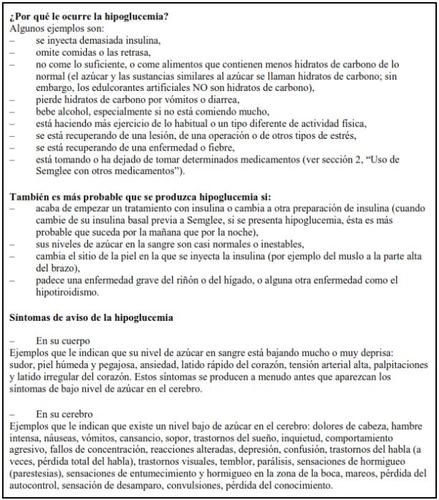

СЕМГЛИ 100 ЕД/МЛ раствор для инъекций в предварительно заполненной ручке

Спросите врача о рецепте на СЕМГЛИ 100 ЕД/МЛ раствор для инъекций в предварительно заполненной ручке

Инструкция по применению СЕМГЛИ 100 ЕД/МЛ раствор для инъекций в предварительно заполненной ручке
Введение
Прошу: информация для пользователя
Semglee 100 единиц/мл раствор для инъекций в предварительно заполненной ручке
инсулин гларгин
Это лекарство подлежит дополнительному наблюдению, что облегчит обнаружение новой информации о его безопасности. Вы можете внести свой вклад, сообщая о побочных эффектах, которые вы могли бы испытать. Последняя часть раздела 4 содержит информацию о том, как сообщать о этих побочных эффектах.
Прочитайте весь листок внимательно перед началом использования этого лекарства, поскольку он содержит важную информацию для вас.
- Сохраните этот листок, поскольку вам может потребоваться прочитать его снова.
- Если у вас есть какие-либо вопросы, проконсультируйтесь с вашим врачом, фармацевтом или медсестрой.
- Это лекарство было назначено только вам, и его не следует давать другим людям, даже если они имеют те же симптомы, что и вы, поскольку оно может нанести им вред.
- Если вы испытываете побочные эффекты, проконсультируйтесь с вашим врачом или фармацевтом, даже если это побочные эффекты, которые не указаны в этом листке. См. раздел 4.
Содержание листка
- Что такое Semglee и для чего он используется
- Что вам нужно знать перед началом использования Semglee
- Как использовать Semglee
- Возможные побочные эффекты
- Хранение Semglee
- Содержание упаковки и дополнительная информация
1. Что такое Semglee и для чего он используется
Semglee содержит инсулин гларгин. Это модифицированный инсулин, очень похожий на человеческий инсулин.
Semglee используется для лечения сахарного диабета у взрослых пациентов, подростков и детей от 2 лет.
Сахарный диабет - это заболевание, при котором ваш организм не производит достаточно инсулина для контроля уровня сахара в крови. Инсулин гларгин имеет длительное и постоянное действие по снижению уровня сахара в крови.
2. Что вам нужно знать перед началом использования Semglee
Не используйте Semglee
- если вы аллергичны к инсулину гларгину или к любому другому компоненту этого лекарства (указанному в разделе 6).
Предостережения и меры предосторожности
Semglee в предварительно заполненной ручке подходит только для подкожных инъекций. Проконсультируйтесь с вашим врачом, если необходимо вводить инсулин другим методом.
Проконсультируйтесь с вашим врачом, фармацевтом или медсестрой перед началом использования Semglee.
Соблюдайте строго инструкции по дозировке, контролю (анализам крови и мочи), диете и физической активности (физическому труду и упражнениям), а также технике инъекции, которые были установлены с вашим врачом.
Если ваш уровень сахара в крови слишком низок (гипогликемия), следуйте руководству по гипогликемии (см. рамку в конце этого листка).
Путешествия
Проконсультируйтесь с вашим врачом перед поездкой. Вам, возможно, придется проконсультироваться о:
- доступности вашего инсулина в стране, которую вы собираетесь посетить,
- резерве инсулина, иглах и т. д.,
- правильном хранении инсулина во время путешествия,
- графике приема пищи и введения инсулина во время путешествия,
- возможных эффектах перехода в зоны с разными часовыми поясами,
- возможных новых рисках для здоровья в странах, которые вы собираетесь посетить,
- том, что вам нужно делать в ситуациях экстренного реагирования, когда вы чувствуете себя плохо или заболеваете.
Заболевания и травмы
Управление вашим диабетом может потребовать особого ухода в следующих ситуациях (например, коррекции дозы инсулина, анализов крови и мочи):
- Если вы больны или получили серьезную травму, ваш уровень сахара в крови может повыситься (гипергликемия).
- Если вы не едите достаточно, ваш уровень сахара в крови может понизиться слишком сильно (гипогликемия).
В большинстве случаев вам понадобится врач. Убедитесь, что вы проконсультируетесь с врачом немедленно.
Если у вас диабет 1-го типа (инсулинозависимый диабет), не прекращайте вводить инсулин и принимать достаточное количество углеводов. Всегда информируйте людей, которые занимаются вашим уходом или лечением, о том, что вам нужен инсулин.
Лечение инсулином может вызвать производство антител к инсулину (веществ, которые действуют против инсулина) в вашем организме. Однако только в очень редких случаях вам может потребоваться изменить дозу инсулина.
Некоторые пациенты с диабетом 2-го типа и сердечно-сосудистыми заболеваниями или инсультом, которые были лечены пиоглитазоном (оральным антидиабетическим препаратом, используемым для лечения диабета 2-го типа) и инсулином, испытывали развитие сердечной недостаточности. Сообщите вашему врачу как можно скорее, если вы испытываете симптомы сердечной недостаточности, такие как необычная одышка или быстрое увеличение веса или локализованное отекание (отек).
Дети
Нет опыта использования Semglee у детей младше 2 лет.
Использование Semglee с другими лекарствами
Некоторые лекарства могут вызывать изменения уровня сахара в крови (повышение, понижение или оба, в зависимости от ситуации). В каждом случае может потребоваться коррекция дозы инсулина для предотвращения слишком низких или слишком высоких уровней сахара в крови. Будьте осторожны, когда начинаете принимать другое лекарство, и когда перестаете его принимать.
Сообщите вашему врачу или фармацевту, если вы принимаете, недавно принимали или можете принять любое другое лекарство. Спросите вашего врача, прежде чем принимать лекарство, может ли оно повлиять на ваш уровень сахара в крови, и какие меры вам нужно принять в вашем случае.
Среди лекарств, которые могут вызвать понижение уровня сахара в крови (гипогликемию), включены:
- все другие лекарства для лечения диабета,
- ингибиторы ангиотензин-превращающего фермента (АПФ) (используемые для лечения некоторых сердечно-сосудистых заболеваний или повышения артериального давления),
- дисопирамид (используемый для лечения некоторых сердечно-сосудистых заболеваний),
- флуоксетин (используемый для лечения депрессии),
- фибраты (используемые для снижения повышенных уровней липидов в крови),
- ингибиторы моноаминоксидазы (МАО) (используемые для лечения депрессии),
- пентоксифиллин, пропоксифен, салицилаты (такие как ацетилсалициловая кислота, используемая для облегчения боли и снижения температуры),
- антибиотики группы сульфаниламидов.
Среди лекарств, которые могут вызвать повышение уровня сахара в крови (гипергликемию), включены:
- кортикостероиды (такие как "кортизон", используемый для лечения воспаления),
- даназол (лекарство, действующее на овуляцию),
- диазоксид (используемый для лечения повышения артериального давления),
- диуретики (используемые для лечения повышения артериального давления или избыточной задержки жидкости),
- глюкагон (поджелудочная гормон, используемый для лечения тяжелой гипогликемии),
- изониазид (используемый для лечения туберкулеза),
- эстрогены и прогестагены (такие как в противозачаточной таблетке, используемой для контроля над рождаемостью),
- производные фенотиазина (используемые для лечения психиатрических заболеваний),
- соматотропин (гормон роста),
- симпатомиметические лекарства (такие как адреналин или сальбутамол, тербуталин для лечения астмы),
- тиреоидные гормоны (используемые для лечения дисфункции щитовидной железы),
- атипичные антипсихотические лекарства (такие как клозапин, оланзапин),
- ингибиторы протеазы (используемые для лечения ВИЧ).
Ваш уровень сахара в крови может повыситься или понизиться, если вы принимаете:
- бета-блокаторы (используемые для лечения повышения артериального давления),
- клонидин (используемый для лечения повышения артериального давления),
- соли лития (используемые для лечения психиатрических заболеваний).
Пентамидина (используемая для лечения некоторых инфекций, вызванных паразитами) может вызвать гипогликемию, которая иногда может быть за ней гипергликемией.
Бета-блокаторы, как и другие симпатомиметические лекарства (такие как клонидин, гуанетидин и резерпин), могут уменьшить или полностью устранить первые симптомы предупреждения, которые могут помочь вам распознать гипогликемию.
Если вы не уверены, принимаете ли вы одно из этих лекарств, проконсультируйтесь с вашим врачом или фармацевтом.
Использование Semglee с алкоголем
Ваши уровни сахара в крови могут повыситься или понизиться, если вы употребляете алкоголь.
Беременность и лактация
Проконсультируйтесь с вашим врачом или фармацевтом перед использованием любого лекарства.
Сообщите вашему врачу, если вы планируете стать беременной или если вы уже беременны. Ваша доза инсулина может потребовать коррекции во время беременности и после родов. Особенно тщательный контроль над диабетом и предотвращение гипогликемии важны для здоровья вашего ребенка.
Если вы в период лактации, проконсультируйтесь с вашим врачом, поскольку вам может потребоваться коррекция дозы инсулина и диеты.
Вождение и использование машин
Ваша способность концентрироваться или реагировать может быть снижена, если:
- у вас гипогликемия (низкий уровень сахара в крови),
- у вас гипергликемия (высокий уровень сахара в крови),
- у вас проблемы с зрением.
Будьте осторожны с этой возможной проблемой, учитывая все ситуации, которые могут быть причиной риска для вас или других (таких как вождение транспортного средства или использование машин). Вы должны попросить вашего врача, чтобы он посоветовал вам о способности вождению, если:
- у вас частые эпизоды гипогликемии,
- снижены или не появляются первые симптомы предупреждения, которые могут помочь вам распознать гипогликемию.
Semglee содержит натрий
Это лекарство содержит менее 1 ммоль (23 мг) натрия на дозу, что означает, что оно практически "не содержит натрия".
3. Как использовать Semglee
Следуйте точно инструкциям по введению этого лекарства, указанным вашим врачом. В случае сомнений, проконсультируйтесь с вашим врачом или фармацевтом.
Хотя Semglee содержит тот же активный ингредиент, что и инсулин гларгин 300 единиц/мл, эти лекарства не взаимозаменяемы. Переход от одного лечения инсулином к другому требует медицинского назначения, медицинского наблюдения и контроля уровня сахара в крови. Для получения дополнительной информации, проконсультируйтесь с вашим врачом.
Доза
В зависимости от вашего образа жизни и результатов анализов сахара (глюкозы) в крови и предыдущего лечения инсулином, ваш врач:
- определит дозу Semglee, которую вам нужно каждый день и в какое время,
- указывает, когда вам нужно анализировать уровень сахара в крови и если вам нужно проводить анализ мочи,
- указывает, когда вам может потребоваться введение более высокой или более низкой дозы Semglee.
Semglee - это инсулин длительного действия. Ваш врач может указать вам использовать его в сочетании с инсулином короткого действия или таблетками для лечения повышения уровня сахара в крови.
Многие факторы могут влиять на ваш уровень сахара в крови. Вам нужно знать эти факторы, чтобы вы могли правильно реагировать на изменения уровня сахара в крови и предотвратить его слишком сильное повышение или понижение. Для получения дополнительной информации, см. рамку в конце этого листка.
Использование у детей и подростков
Semglee может быть использован у подростков и детей от 2 лет и старше. Используйте это лекарство так, как указал ваш врач.
Частота введения
Вам нужно вводить Semglee один раз в день, всегда в одно и то же время.
Ручка Semglee вводит инсулин в шагах по 1 единице до максимальной единой дозы 80 единиц.
Способ введения
Semglee вводится под кожу. НЕ вводите Semglee в вену, поскольку это изменит его действие и может вызвать гипогликемию.
Ваш врач покажет вам, в какую область кожи вам нужно вводить Semglee. С каждой инъекцией, вы должны менять место укола внутри конкретной области кожи, которую вы используете.
Как обращаться с ручкой Semglee
Semglee в предварительно заполненной ручке подходит только для подкожных инъекций. Проконсультируйтесь с вашим врачом, если необходимо вводить инсулин другим методом.
Внимательно прочитайте "Инструкции по использованию", включенные в этот листок. Вы должны использовать ручку так, как описано в этих инструкциях.
Перед каждым использованием, вставьте новую иглу. Используйте только иглы, совместимые с ручкой Semglee (см. "Инструкции по использованию").
Перед каждой инъекцией, проведите тест безопасности.
Осмотрите картридж перед использованием ручки. Не используйте Semglee, если вы заметите частицы внутри него. Используйте Semglee только если раствор прозрачный и бесцветный. Не встряхивайте и не смешивайте перед использованием.
Чтобы предотвратить возможную передачу заболеваний, никогда не делитесь своей ручкой с кем-либо другим. Эта ручка предназначена только для вашего использования.
Используйте всегда новую ручку, если вы заметите, что ваш контроль над уровнем сахара в крови ухудшается без объяснения. Если вы думаете, что у вас может быть проблема с ручкой Semglee, проконсультируйтесь с вашим врачом, фармацевтом или медсестрой.
Пустые ручки не должны быть заполнены снова и должны быть утилизированы безопасно.
Не используйте ручку Semglee, если она повреждена или не функционирует правильно (из-за механических дефектов), она должна быть утилизирована и использована новая ручка Semglee.
Перепутывание инсулина
Всегда проверяйте этикетку инсулина перед каждой инъекцией, чтобы избежать путаницы между Semglee и другими инсулинами.
Если вы используете больше Semglee, чем нужно
Если вы ввели слишком много Semglee,ваш уровень сахара в крови может стать слишком низким (гипогликемия). Проверяйте ваш уровень сахара в крови часто. В целом, чтобы предотвратить гипогликемию, вам нужно есть больше и контролировать ваш уровень сахара в крови. Для получения дополнительной информации о лечении гипогликемии, см. рамку в конце этого листка.
Если вы забыли использовать Semglee
Если вы забыли дозу Semglee или если вы не ввели достаточно инсулина, ваш уровень сахара в крови может повыситься слишком сильно (гипергликемия). Проверяйте ваш уровень сахара в крови часто. Для получения дополнительной информации о лечении гипергликемии, см. рамку в конце этого листка.
Не принимайте двойную дозу, чтобы компенсировать пропущенные дозы.
Если вы прекратите лечение Semglee
Это может привести к тяжелой гипергликемии (очень высоким уровням сахара в крови) и кетоацидозу (повышению уровня кислоты в крови, потому что организм расщепляет жиры вместо сахара). Не прекращайте лечение Semglee без консультации с вашим врачом, он скажет вам, что делать.
Если у вас есть какие-либо другие вопросы о использовании этого лекарства, проконсультируйтесь с вашим врачом, фармацевтом или медсестрой.
4. Возможные побочные эффекты
Как и все лекарства, Семглее может вызывать побочные эффекты, хотя не все люди их испытывают.
Если вы заметите признаки того, что ваш уровень сахара в крови слишком низок (гипогликемия),действуйте немедленно, чтобы повысить уровень сахара в крови (см. рамку в конце этого листка). Гипогликемия (низкий уровень сахара в крови) может быть очень серьезной и часто встречается во время лечения инсулином (может повлиять на более 1 из 10 человек). Низкий уровень сахара в крови означает, что в крови не хватает сахара. Если ваш уровень сахара в крови сильно снизится, вы можете потерять сознание. Серьезная гипогликемия может вызвать повреждение мозга и может быть потенциально смертельной. Для получения более подробной информации см. рамку в конце этого листка.
Тяжелые аллергические реакции(редко, могут повлиять до 1 из 1000 человек): признаки могут включать кожные реакции в крупном масштабе (сыпь и зуд по всему телу), сильное отекание кожи или слизистых оболочек (ангиеоэдем), затруднение дыхания, снижение артериального давления с учащенным сердцебиением и потоотделением. Тяжелые аллергические реакции на инсулин могут быть потенциально смертельными. Сообщите вашему врачу немедленно, если вы заметите признаки тяжелых аллергических реакций.
Изменения кожи в месте инъекции:
Если инсулин вводится слишком часто в одно и то же место, кожа может стать тоньше (липоатрофия, может повлиять до 1 из 100 человек) или толще (липогипертрофия, может повлиять до 1 из 10 человек). Также могут появиться узлы под кожей, вызванные накоплением белка, называемого амилоидом (кутанная амилоидоз, частота неизвестна). Инсулин может не действовать очень хорошо. Меняйте место инъекции с каждой инъекцией, чтобы помочь предотвратить эти изменения кожи.
Частые побочные эффекты(могут повлиять до 1 из 10 человек)
- Побочные эффекты кожи и аллергические реакции в месте инъекции
Признаки могут включать покраснение, сильную боль при инъекции, зуд, крапивницу, отекание или воспаление. Эти реакции могут распространиться вокруг места инъекции. Большинство легких реакций на инсулин обычно исчезают в течение нескольких дней или недель.
- Побочные эффекты кожи и аллергические реакции в месте инъекции
Признаки могут включать покраснение, сильную боль при инъекции, зуд, крапивницу, отекание или воспаление. Эти реакции могут распространиться вокруг места инъекции. Большинство легких реакций на инсулин обычно исчезают в течение нескольких дней или недель.
Редкие побочные эффекты(могут повлиять до 1 из 1000 человек)
- Глазные реакции
Значительное изменение (улучшение или ухудшение) контроля уровня сахара в крови может временно повлиять на ваше зрение. Если вы страдаете пролиферативной ретинопатией (заболеванием глаз, связанным с диабетом), тяжелые гипогликемические приступы могут вызвать временную потерю зрения.
- Общие расстройства
В редких случаях лечение инсулином также может вызвать временное накопление воды в организме, с отеканием икр и лодыжек.
Очень редкие побочные эффекты(могут повлиять до 1 из 10 000 человек)
В очень редких случаях может произойти дисгевзия (нарушение вкуса) и миалгия (мышечная боль).
Применение у детей и подростков
В целом, побочные эффекты у детей и подростков в возрасте 18 лет или младше подобны тем, которые встречаются у взрослых.
Более часто сообщаются о реакциях в месте инъекции (реакция в месте инъекции, боль в месте инъекции) и кожных реакциях (сыпь, крапивница) у детей или подростков в возрасте 18 лет или младше, чем у взрослых.
Нет опыта использования у детей младше 2 лет.
Сообщение о побочных эффектах
Если вы испытываете побочные эффекты, проконсультируйтесь с вашим врачом или фармацевтом. Это включает возможные побочные эффекты, которые не перечислены в этом листке. Вы также можете сообщить о них напрямую через национальную систему уведомления, включенную в Приложение V. Сообщая о побочных эффектах, вы можете внести свой вклад в предоставление более подробной информации о безопасности этого лекарства.
5. Хранение Семглее
Храните это лекарство в недоступном для детей месте.
Не используйте это лекарство после даты истечения срока годности, указанной на упаковке и на этикетке ручки после CAD/EXP. Дата истечения срока годности - последний день месяца, указанного.
Неиспользованные ручки
Храните в холодильнике (при температуре между 2 °C и 8 °C). Не замораживайте и не размещайте рядом с морозильным отделением или охладителем.
Храните предзагруженную ручку в наружной упаковке, чтобы защитить ее от света.
Ручки в использовании
Предзагруженная ручка в использовании или для переноски должна храниться не более 4 недель при температуре ниже 30 °C и защищена от прямого тепла или света. Не используйте после этого периода. Ручка в использовании не должна храниться в холодильнике.
Крышку ручки необходимо возвращать на место после каждой инъекции, чтобы защитить ее от света.
Удалите иглу после инъекции и храните ручку без иглы. Также убедитесь, что удалили иглу перед утилизацией ручки. Иглы не должны повторно использоваться.
Лекарства не должны выбрасываться в канализацию или в мусор. Спросите вашего фармацевта, как утилизировать упаковку и лекарства, которые вам больше не нужны. Таким образом, вы поможете защитить окружающую среду.
6. Содержимое упаковки и дополнительная информация
Состав Семглеи
- Активное вещество - инсулин гларгин. Каждый мл раствора содержит 100 единиц инсулина гларгина (эквивалентно 3,64 мг).
- Другие компоненты: хлорид цинка, метакрезол, глицерол, гидроксид натрия (для регулирования pH) (см. раздел 2 «Семглея содержит натрий»), соляная кислота (для регулирования pH) и вода для инъекционных препаратов.
Внешний вид продукта и содержимое упаковки
Семглея 100 единиц/мл раствор для инъекций в предварительно заполненной笔е - прозрачный бесцветный раствор.
Каждая笔а содержит 3 мл раствора для инъекций (эквивалентно 300 единицам).
Семглея выпускается в упаковках по 1, 3, 5 и 10笔 или в многопачковых упаковках, содержащих 2 блока, каждый из которых содержит 5笔.
Возможно, что будут продаваться только некоторые размеры упаковок.
Владелец разрешения на маркетинг
Biosimilar Collaborations Ireland Limited
Unit 35/36
Grange Parade,
Baldoyle Industrial Estate,
Дублин 13
ДУБЛИН
Ирландия
D13 R20R
Производитель
Biosimilar Collaborations Ireland Limited
Block B, The Crescent Building, Santry Demesne
Дублин
D09 C6X8
Ирландия
Вы можете получить больше информации о этом лекарстве, обратившись к местному представителю владельца разрешения на маркетинг:
Бельгия/Белгique/Бельгия Biocon Biologics Belgium BV Тел: 0080008250910 | Литва Biosimilar Collaborations Ireland Limited Тел: 0080008250910 |
Греция Biosimilar Collaborations Ireland Limited Тел: 0080008250910 | Люксембург/Люксембург Biocon Biologics France S.A.S Тел: 0080008250910 |
Чехия Biocon Biologics Germany GmbH Тел: 0080008250910 | Венгрия Biosimilar Collaborations Ireland Limited Тел: 0080008250910 |
Дания Biocon Biologics Finland OY Тел: 0080008250910 | Мальта Biosimilar Collaborations Ireland Limited Тел: 0080008250910 |
Германия Biocon Biologics Germany GmbH Тел: 0080008250910 | Нидерланды Biocon Biologics France S.A.S Тел: 0080008250910 |
Эстония Biosimilar Collaborations Ireland Limited Тел: 0080008250910 | Норвегия Biocon Biologics Finland OY Тел: +47 800 62 671 |
Греция Biocon Biologics Greece ΜΟΝΟΠΡΟΣΩΠΗ Ι.Κ.Ε Тел: 0080008250910 | Австрия Biocon Biologics Germany GmbH Тел: 0080008250910 |
Испания Biocon Biologics Spain S.L. Тел: 0080008250910 | Польша Biosimilar Collaborations Ireland Limited Тел: 0080008250910 |
Франция Biocon Biologics France S.A.S Тел: 0080008250910 | Португалия Biocon Biologics Spain S.L. Тел: 0080008250910 |
Хорватия Biocon Biologics Germany GmbH Тел: 0080008250910 | Румыния Biosimilar Collaborations Ireland Limited Тел: 0080008250910 |
Ирландия Biosimilar Collaborations Ireland Limited Тел: 1800 777 794 | Словения Biosimilar Collaborations Ireland Limited Тел: 0080008250910 |
Исландия Biocon Biologics Finland OY Тел: +345 8004316 | Словакия Biocon Biologics Germany GmbH Тел: 0080008250910 |
Италия Biocon Biologics Spain S.L. Тел: 0080008250910 | Финляндия Biocon Biologics Finland OY Тел: 99980008250910 |
Кипр Biosimilar Collaborations Ireland Limited Тел: 0080008250910 | Швеция Biocon Biologics Finland OY Тел: 0080008250910 |
Латвия Biosimilar Collaborations Ireland Limited Тел: 0080008250910 |
Дата последнего пересмотра этого листка: {месяц ГГГГ}.
Другие источники информации
Подробная информация о этом лекарстве доступна на сайте Европейского агентства по лекарственным средствам: http://www.ema.europa.eu.
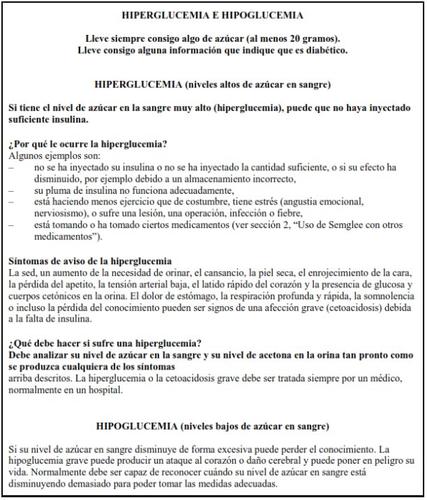
Семглея 100 единиц/мл раствор для инъекций в предварительно заполненной笔е. ИНСТРУКЦИИ ПО ПРИМЕНЕНИЮ
Внимательно прочитайте эти инструкции по применению и листок-вкладыш перед использованием предварительно заполненной笔и Семглеи и каждый раз, когда используете новую笔у. В них может быть новая информация. Эта информация не заменяет консультацию с вашим врачом, медсестрой или фармацевтом о вашем состоянии здоровья или лечении. Если вы не можете прочитать или выполнить все инструкции самостоятельно, попросите помощи у кого-то, кто обучен использовать эту笔у. Не рекомендуется, чтобы слепые или имеющие нарушения зрения люди использовали эту笔у без помощи обученного человека.
Если вы не будете следовать этим инструкциям каждый раз, когда используете笔у, вы можете вводить слишком много или слишком мало инсулина. Это может повлиять на уровень сахара в вашей крови.
Семглея - это одноразовая предварительно заполненная笔а-инъектор, содержащая 300 единиц инсулина гларгина в 3 мл раствора (100 единиц/мл). Вы можете вводить от 1 до 80 единиц за одну инъекцию.
Не делитесь предварительно заполненной笔ой Семглеи с другим человеком, даже если вы поменяли иглу. Вы можете передать другому человеку серьезную инфекцию или заразиться через него.
Сборка笔и:
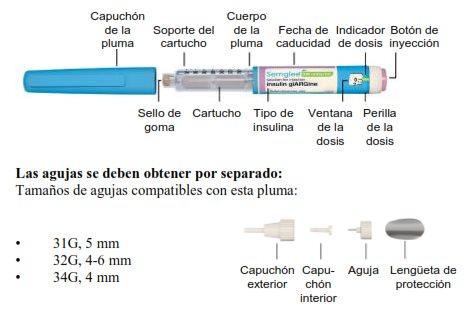
Необходимые принадлежности:
Убедитесь, что у вас есть следующие предметы перед тем, как вводить дозу:
- Предварительно заполненная笔а Семглеи
- Стерильная одноразовая гиподермическая игла, совместимая с этой笔ой
- 2 ватных шарика с алкоголем
- Контейнер для утилизации острых предметов
Хранение
До первого использования笔и храните упаковки, содержащие笔у, в холодильнике
(2 °C–8 °C).
Незамораживайте笔у.
После того, как вы достали笔у из холодильника, положите ее на ровную поверхность и подождите, пока она достигнет комнатной температуры, между 15 °C и 30 °C, перед использованием.
После первого использования笔и храните ее при комнатной температуре до максимальной температуры
30 °C. Не возвращайте笔у в холодильник после использования.
Всегда храните笔у с колпачком, чтобы избежать загрязнения.
Вы должны утилизировать笔у, которую используете, после 4 недель с момента первого использования, даже если в ней еще остается инсулин. См. шаг 8 для получения инструкций по утилизации.
Неоставляйте иглу на笔е во время хранения и не повторно используйте иглы. Держите笔у и иглы вне поля зрения и досягаемости детей.
Используйте всегда новую стерильную иглу для каждой инъекции, поскольку это предотвращает засорение игл и инфекции.
Каждый раз, когда вы используете笔у
- Мойте руки водой и мылом перед использованием笔и.
- Проверьте этикетку на笔е, чтобы убедиться, что вы вводите правильный тип инсулина. У笔и есть фиолетовая и белая этикетка и фиолетовая кнопка инъекции.
- Проверьте дату истечения срока годности на этикетке на笔е. Не используйте ее после этой даты.
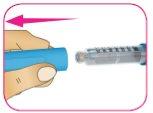
Шаг 1. Подготовка笔и
А - Осмотрите笔у: проверьте фиолетовую и белую этикетку на笔е, чтобы убедиться, что:
- Это правильный тип инсулина.
- Не истекла дата истечения срока годности.
Б - Держите корпус笔и одной рукой. Снимите колпачок с笔и другой рукой. Отложите колпачок, чтобы использовать его позже.
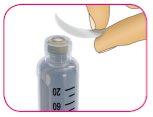
Шаг 2. Установка новой иглы
А - Возьмите новую стерильную одноразовую иглу и снимите защитный колпачок. Неиспользуйте иглу, если защитный колпачок поврежден или отсутствует, поскольку игла может быть загрязнена.
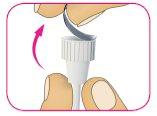
Б - Держа корпус иглы вверх, установите внешний колпачок иглы непосредственно на держатель картриджа, как показано. Если вы попытаетесь установить внешний колпачок сбоку, игла может согнуться или повредиться.
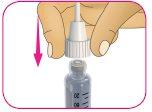
В - Поверните внешний колпачок иглы по часовой стрелке (вправо) до тех пор, пока не почувствуете, что он плотно закреплен на笔е.
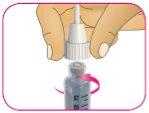
Г - Аккуратно снимите внешний колпачок иглы и отложите его. Не выбрасывайте его, поскольку вам понадобится позже.
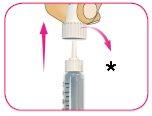
*Сохраните внешний колпачок
Д - Аккуратно снимите внутренний колпачок иглы и выбросьте его.
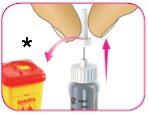
- Выбросьте внутренний колпачок
Шаг 3. Подготовка иглы笔и
А - Подготовьте всегда новую иглу笔и перед каждой инъекцией.
Б - Поверните белую дозирующую рукоятку на 2 единицы дозы. Вы услышите «щелчок» за каждую единицу, которую поворачиваете.
Если вы поворачиваете больше, чем 2 единицы по ошибке, поверните дозирующую рукоятку в противоположном направлении, чтобы исправить количество единиц.
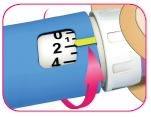
Б - Держите корпус笔и вверх одной рукой.
Г - Аккуратно постучите по картриджу пальцем, чтобы помочь большим пузырькам воздуха переместиться в верхнюю часть картриджа. Возможно, вы все еще увидите небольшие пузырьки. Это нормально.
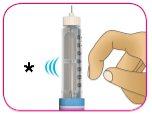
- ПОСТУЧИТЕ
Д - С笔ой, направленной вверх, нажмите кнопку инъекции до тех пор, пока она не перестанет двигаться, и окно дозировки покажет «0».
Е - Повторите шаги 3Б-3Е еще три раза, пока не увидите капли инсулина на кончике иглы.
Подготовка завершается, когда вы увидите капли инсулина.
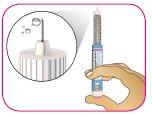
Если вы не видите инсулина на кончике иглы после 4 попыток подготовки, игла может быть заблокирована. Если это происходит:
- Перейдите к шагу 7, чтобы получить инструкции по безопасному удалению иглы.
- Начните процесс заново на шаге 2А, чтобы установить и подготовить новую иглу.
Шаг 4. Выбор дозы
А - Проверьте, что в окне дозировки показано «0».
Б - Поверните белую дозирующую рукоятку до тех пор, пока желтый индикатор дозы не совпадет с желаемой дозой.
Пока вы поворачиваете белую дозирующую рукоятку, чтобы установить свою дозу, она будет продвигаться, и вы услышите «щелчок» за каждую единицу.
Дозу можно исправить; для этого необходимо повернуть дозирующую рукоятку в любом направлении до тех пор, пока правильная доза не совпадет с желтым индикатором дозы.

Пример 48 единиц, выбранных
Пена не позволит вам установить дозу, превышающую количество единиц, оставшихся впене. Если ваша доза превышает количество единиц, оставшихся впене:
- Введение количества, оставшегося впене, и использование новойпени для введения остальной части дозы
или
- Возьмите новуюпену и введение полной дозы.
Незаставляйте дозирующую рукоятку более 80 единиц.
Ненажимайте фиолетовую кнопку инъекции, пока поворачиваете дозирующую рукоятку.
Шаг 5. Выбор и очистка точки инъекции
А - Выберите точку инъекции, как вам объяснил медицинский работник, очистите эту область новым ватным шариком с алкоголем и дайте коже высохнуть перед введением дозы.
Точки инъекции включают руки, бедра, ягодицы и живот. Вы должны менять точки инъекции для каждой инъекции.
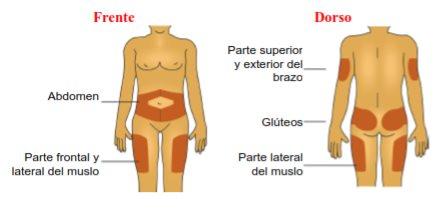
Шаг 6. Введение дозы
А - Если это указано медицинским работником, вы можете защипнуть чистую кожу между пальцами.
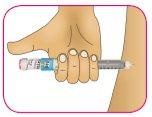
Б - Введите иглу в кожу прямо, как вам указал медицинский работник.
Невводите иглу под углом.
В - Нажмите фиолетовую кнопку инъекции до конца. Белая дозирующая рукоятка повернется, и вы услышите «щелчки» при нажатии.
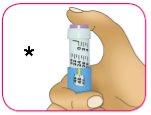
- НАЖМИТЕ, ЧТОБЫ ВВЕСТИ
Г - Держите нажатой фиолетовую кнопку инъекции в течение 10 секунд после того, как в окне дозировки появится «0», чтобы убедиться, что вся инсулина введена. Если вы не держите нажатой кнопку инъекции в течение 10 секунд после того, как в окне дозировки появится «0», вы можете получить неправильную дозу препарата.
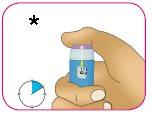
- ДЕРЖИТЕ НАЖАТОЙ В ТЕЧЕНИЕ 10 СЕКУНД
Ненажимайте кнопку инъекции сбоку и не блокируйте белую дозирующую рукоятку пальцами, поскольку это не позволит вам ввести препарат.
Шаг 7. После инъекции
А - Возьмите внешний колпачок иглы, который вы отложили на шаге 2Д, держите его за широкую часть и аккуратно накройте иглу, не касаясь ее.
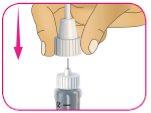
Б - Зажмите широкую часть внешнего колпачка иглы и поверните иглу против часовой стрелки (влево). Продолжайте поворачивать иглу, пока она не выйдет изпени. Возможно, вам придется сделать несколько поворотов, чтобы освободить иглу.
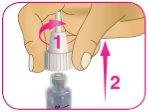
В - Поместите иглу в контейнер для утилизации острых предметов (см. шаг 8 для получения инструкций по утилизации).
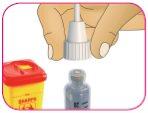
Г - Верните колпачок на место на картридже.
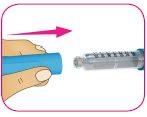
Д - Хранитепену при комнатной температуре (ниже 30 °C). Нехранитепену с использованной иглой.
Шаг 8. Утилизация
Поместите использованную иглу в контейнер для утилизации острых предметов сразу после использования. Невыбрасывайте (не утилизируйте) отдельные иглы в контейнер для домашних отходов.
Если у вас нет контейнера для острых предметов, вы можете использовать домашний контейнер, который:
- изготовлен из прочного пластика,
- может быть закрыт плотно прилегающей крышкой, устойчивой к проколам, которая не позволяет острым предметам выходить из контейнера,
- остается прямым и устойчивым во время использования,
- герметичен и
- правильно маркирован, чтобы предупредить о опасных отходах внутри контейнера.
Использованнуюпену можно утилизировать в контейнере для домашних отходов после удаления иглы.
Уход за пеной
- Всегда носите с собой дополнительный автоинъектор инсулина, как рекомендовано медицинским работником, на случай, если вашапена потеряется или будет повреждена.
- Используйте всегда новую стерильную иглу для каждой инъекции.
- le y стерильна для каждой инъекции.
- Держите ручку подальше от влаги, пыли, прямых солнечных лучей и мест, где температура может слишком сильно повышаться или понижаться (см. раздел хранения в начале этих инструкций).
- Вы можете очистить внешнюю часть своей ручки влажной тканью.
- Избегайте падения ручки, поскольку это может привести к разрыву картриджа или повреждению ручки.
- Неделитесь своей ручкой с другими людьми, даже если вы изменили иглу. Вы можете передать другим тяжелую инфекцию или заразиться от них.
- Незамачивайте и не мойте ручку. Неиспользуйте алкоголь, перекись водорода, отбеливатель или любую другую жидкость для очистки ручки. Ненаносите смазки, такие как масло. Это может повредить ручку.
- Непытайтесь ремонтировать неработоспособную или поврежденную ручку. Удалите иглу, как описано в шаге 7, и утилизируйте ручку или верните ее в аптеку. Используйте новую ручку вместо нее.

Сколько стоит СЕМГЛИ 100 ЕД/МЛ раствор для инъекций в предварительно заполненной ручке в Испании в 2025 году?
Средняя цена на СЕМГЛИ 100 ЕД/МЛ раствор для инъекций в предварительно заполненной ручке в ноябрь, 2025 года составляет около 56.25 евро. Финальная стоимость может зависеть от региона, конкретной аптеки и рецептурного статуса. Для точной информации лучше проверить онлайн или в ближайшей аптеке.
- Страна регистрации
- Средняя цена в аптеках56.25 EUR
- Активное вещество
- Требуется рецептДа
- Производитель
- Информация носит справочный характер и не является медицинской рекомендацией. Перед приемом любых препаратов проконсультируйтесь с врачом. Oladoctor не несет ответственности за медицинские решения, принятые на основе этого контента.
- Аналоги СЕМГЛИ 100 ЕД/МЛ раствор для инъекций в предварительно заполненной ручкеФорма выпуска: ИНЪЕКЦИОННЫЙ РАСТВОР, 100 ЕД/млАктивное вещество: инсулин гларгинПроизводитель: Eli Lilly Nederland B.V.Требуется рецептФорма выпуска: ИНЪЕКЦИОННЫЙ РАСТВОР, НеизвестноАктивное вещество: инсулин гларгинПроизводитель: Sanofi-Aventis Deutschland GmbhТребуется рецептФорма выпуска: ИНЪЕКЦИОННЫЙ, НеизвестноАктивное вещество: инсулин гларгинПроизводитель: Sanofi-Aventis Deutschland GmbhТребуется рецепт
Аналоги СЕМГЛИ 100 ЕД/МЛ раствор для инъекций в предварительно заполненной ручке в других странах
Лучшие аналоги с тем же действующим веществом и терапевтическим эффектом.
Аналог СЕМГЛИ 100 ЕД/МЛ раствор для инъекций в предварительно заполненной ручке в Украина
Врачи онлайн по СЕМГЛИ 100 ЕД/МЛ раствор для инъекций в предварительно заполненной ручке
Консультация по дозировке, побочным эффектам, взаимодействиям, противопоказаниям и продлению рецепта на СЕМГЛИ 100 ЕД/МЛ раствор для инъекций в предварительно заполненной ручке – по решению врача и с учетом местных правил.




